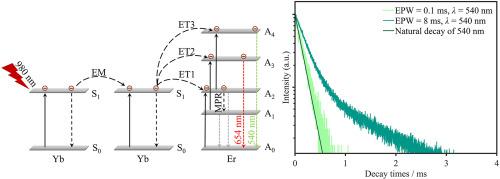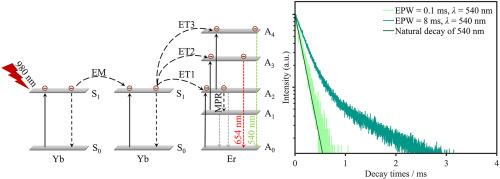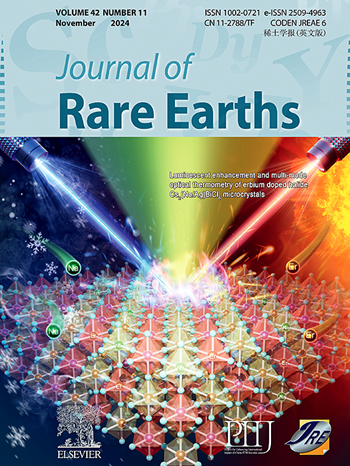Control upconversion decay dynamics from perspective of collective response
IF 7.2
1区 化学
Q1 CHEMISTRY, APPLIED
引用次数: 0
Abstract
Very recently, upconversion luminescence (UCL) lifetime, as a powerful optical dimension, has attracted tremendous research interest due to its advantages of high information capacity and high photophysical stability. With the implementation and emergence of endlessly fascinating UCL features, it is particularly meaningful to understand the photophysical mechanisms inside UCL materials to enable rational subdivision-level structure design, which is however currently far from sufficient. In this work, we take an ordinary upconversion nanoparticle as an example to prove that the UCL decay curves and corresponding lifetimes are indeed a collective response of the entire UCL system to excitations, that exhibits correlated, yet quite different properties from individual ions. A specially developed theoretical random walk model combined with an experimental lifetime control for Yb3+/Er3+ UCL demonstrates that energy diffusion principally alters the decay rate. Moreover, the different extent of the influence of energy diffusion on the emissions of 2H11/2/4S3/2 (green) and 4F9/2 (red) leads to an extremely uncommon cross-over comparison of decay rates. This work provides new ideas for understanding decay dynamics and practical UCL lifetime manipulation methods.


从集体响应的角度控制上转换衰减动力学
上转换发光(UCL)寿命作为一种强大的光学维度,由于其具有高信息容量和光物理稳定性等优点,近年来引起了广泛的研究兴趣。随着令人着迷的UCL特性的不断实现和出现,了解UCL材料内部的光物理机制对于进行合理的细分级结构设计尤为有意义,但目前这方面的工作还远远不够。在这项工作中,我们以一个普通的上转换纳米粒子为例,证明了UCL衰变曲线和相应的寿命确实是整个UCL系统对激励的集体响应,它表现出与单个离子相关但又截然不同的特性。结合Yb3+/Er3+ UCL的实验寿命控制,专门开发的理论随机游走模型表明,能量扩散主要改变衰变速率。此外,能量扩散对2H11/2/4S3/2(绿色)和4F9/2(红色)发射的影响程度不同,导致衰变速率的交叉比较极为罕见。这项工作为理解衰变动力学和实际的UCL寿命操纵方法提供了新的思路。
本文章由计算机程序翻译,如有差异,请以英文原文为准。
求助全文
约1分钟内获得全文
求助全文
来源期刊

Journal of Rare Earths
化学-应用化学
CiteScore
8.70
自引率
14.30%
发文量
374
审稿时长
1.7 months
期刊介绍:
The Journal of Rare Earths reports studies on the 17 rare earth elements. It is a unique English-language learned journal that publishes works on various aspects of basic theory and applied science in the field of rare earths (RE). The journal accepts original high-quality original research papers and review articles with inventive content, and complete experimental data. It represents high academic standards and new progress in the RE field. Due to the advantage of abundant RE resources of China, the research on RE develops very actively, and papers on the latest progress in this field emerge every year. It is not only an important resource in which technicians publish and obtain their latest research results on RE, but also an important way of reflecting the updated progress in RE research field.
The Journal of Rare Earths covers all research and application of RE rare earths including spectroscopy, luminescence and phosphors, rare earth catalysis, magnetism and magnetic materials, advanced rare earth materials, RE chemistry & hydrometallurgy, RE metallography & pyrometallurgy, RE new materials, RE solid state physics & solid state chemistry, rare earth applications, RE analysis & test, RE geology & ore dressing, etc.
 求助内容:
求助内容: 应助结果提醒方式:
应助结果提醒方式:


